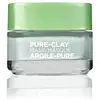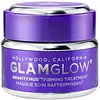What's inside
What's inside
 Key Ingredients
Key Ingredients

 Benefits
Benefits

 Concerns
Concerns

 Ingredients Side-by-side
Ingredients Side-by-side

Water
Skin ConditioningKaolin
AbrasiveMontmorillonite
AbsorbentSilica
AbrasiveLecithin
EmollientPolysorbate 20
EmulsifyingButylene Glycol
HumectantPropylene Glycol
HumectantOryza Sativa Starch
AbsorbentEucalyptus Globulus Leaf Extract
PerfumingGlycerin
HumectantMoroccan Lava Clay
AbrasiveCaprylyl Glycol
EmollientCitric Acid
BufferingXanthan Gum
EmulsifyingMethylparaben
PreservativeSodium Benzoate
MaskingSodium Methylparaben
PreservativePhenoxyethanol
PreservativeChlorphenesin
AntimicrobialCI 61570
Cosmetic ColorantCI 77492
Cosmetic ColorantLinalool
PerfumingGeraniol
PerfumingCoumarin
PerfumingCitronellol
PerfumingParfum
MaskingWater, Kaolin, Montmorillonite, Silica, Lecithin, Polysorbate 20, Butylene Glycol, Propylene Glycol, Oryza Sativa Starch, Eucalyptus Globulus Leaf Extract, Glycerin, Moroccan Lava Clay, Caprylyl Glycol, Citric Acid, Xanthan Gum, Methylparaben, Sodium Benzoate, Sodium Methylparaben, Phenoxyethanol, Chlorphenesin, CI 61570, CI 77492, Linalool, Geraniol, Coumarin, Citronellol, Parfum
Water
Skin ConditioningPolyvinyl Alcohol
Alcohol Denat.
AntimicrobialButylene Glycol
HumectantGlycerin
HumectantEthylhexyl Hydroxystearate
EmollientHamamelis Virginiana Water
AstringentMontmorillonite
AbsorbentPentylene Glycol
Skin ConditioningIllite
AbrasivePolysorbate 20
EmulsifyingCanadian Colloidal Clay
Skin ConditioningCaprylyl Glycol
EmollientAlthaea Officinalis Leaf Extract
Skin ConditioningTapioca Starch
Chondrus Crispus
MaskingColloidal Platinum
AntimicrobialDipotassium Glycyrrhizate
HumectantAlcohol
AntimicrobialAscophyllum Nodosum Powder
Skin ConditioningPolysorbate 80
EmulsifyingPolymethylsilsesquioxane
Hydroxypropyl Methylcellulose
Emulsion StabilisingCitric Acid
BufferingLecithin
EmollientPullulan
Porphyridium Cruentum Extract
Skin ConditioningSoy Isoflavones
Skin ConditioningSodium Hyaluronate
HumectantXanthan Gum
EmulsifyingParfum
MaskingCoumarin
PerfumingDisodium EDTA
Phenoxyethanol
PreservativeSorbic Acid
PreservativePotassium Sorbate
PreservativeCI 77163
Cosmetic ColorantWater, Polyvinyl Alcohol, Alcohol Denat., Butylene Glycol, Glycerin, Ethylhexyl Hydroxystearate, Hamamelis Virginiana Water, Montmorillonite, Pentylene Glycol, Illite, Polysorbate 20, Canadian Colloidal Clay, Caprylyl Glycol, Althaea Officinalis Leaf Extract, Tapioca Starch, Chondrus Crispus, Colloidal Platinum, Dipotassium Glycyrrhizate, Alcohol, Ascophyllum Nodosum Powder, Polysorbate 80, Polymethylsilsesquioxane, Hydroxypropyl Methylcellulose, Citric Acid, Lecithin, Pullulan, Porphyridium Cruentum Extract, Soy Isoflavones, Sodium Hyaluronate, Xanthan Gum, Parfum, Coumarin, Disodium EDTA, Phenoxyethanol, Sorbic Acid, Potassium Sorbate, CI 77163
Ingredients Explained
These ingredients are found in both products.
Ingredients higher up in an ingredient list are typically present in a larger amount.
Butylene Glycol (or BG) is used within cosmetic products for a few different reasons:
Overall, Butylene Glycol is a safe and well-rounded ingredient that works well with other ingredients.
Though this ingredient works well with most skin types, some people with sensitive skin may experience a reaction such as allergic rashes, closed comedones, or itchiness.
Learn more about Butylene GlycolCaprylyl Glycol is a humectant and emollient, meaning it attracts and preserves moisture.
It is a common ingredient in many products, especially those designed to hydrate skin. The primary benefits are retaining moisture, skin softening, and promoting a healthy skin barrier.
Though Caprylyl Glycol is an alcohol derived from fatty acids, it is not the kind that can dry out skin.
This ingredient is also used as a preservative to extend the life of products. It has slight antimicrobial properties.
Learn more about Caprylyl GlycolCitric Acid is an alpha hydroxy acid (AHA) naturally found in citrus fruits like oranges, lemons, and limes.
Like other AHAs, citric acid can exfoliate skin by breaking down the bonds that hold dead skin cells together. This helps reveal smoother and brighter skin underneath.
However, this exfoliating effect only happens at high concentrations (20%) which can be hard to find in cosmetic products.
Due to this, citric acid is usually included in small amounts as a pH adjuster. This helps keep products slightly more acidic and compatible with skin's natural pH.
In skincare formulas, citric acid can:
While it can provide some skin benefits, research shows lactic acid and glycolic acid are generally more effective and less irritating exfoliants.
Most citric acid used in skincare today is made by fermenting sugars (usually from molasses). This synthetic version is identical to the natural citrus form but easier to stabilize and use in formulations.
Read more about some other popular AHA's here:
Learn more about Citric AcidCoumarins are a group of substances found naturally in plants. There are over 1300 types of coumarins identified. It has a natural vanilla scent.
Coumarin is an identified EU known allergy, meaning it may cause an allergic reaction when applied to the skin.
In many countries, coumarin is banned as a food additive. However, it can be found in soaps, tobacco products, and some alcohol drinks.
Plants use coumarins as a chemical defense. Some plants that have coumarins include lavender, tonka beans, and yellow clovers.
Learn more about CoumarinGlycerin is already naturally found in your skin. It helps moisturize and protect your skin.
A study from 2016 found glycerin to be more effective as a humectant than AHAs and hyaluronic acid.
As a humectant, it helps the skin stay hydrated by pulling moisture to your skin. The low molecular weight of glycerin allows it to pull moisture into the deeper layers of your skin.
Hydrated skin improves your skin barrier; Your skin barrier helps protect against irritants and bacteria.
Glycerin has also been found to have antimicrobial and antiviral properties. Due to these properties, glycerin is often used in wound and burn treatments.
In cosmetics, glycerin is usually derived from plants such as soybean or palm. However, it can also be sourced from animals, such as tallow or animal fat.
This ingredient is organic, colorless, odorless, and non-toxic.
Glycerin is the name for this ingredient in American English. British English uses Glycerol/Glycerine.
Learn more about GlycerinLecithin is a term for a group of substances found in the cell membranes of plants, animals, and humans. They are made up of mixture of phospholipids.
This ingredient has emollient and emulsifying properties.
As an emollient, lecithen helps soften the skin and creates a barrier to keep moisture in.
As an emulsifier, it also helps prevent water and oil ingredients from separating. Lecithin can also help ingredients be better absorbed by the skin.
This is because the phospholipids in lecithin produce liposomes. Liposomes help other ingredients get through the skin barrier.
Depending on the source of this ingredient, lecithin may not be fungal acne safe. This is because some sources of lecithin come from soybean oil, which may feed the malassezia yeast that feeds fungal acne.
We recommend reaching out to the brand you are purchasing from to inquire about the source of their lecithin.
Some other names for this ingredient include soy lecithin and deoiled soy lecithin.
Learn more about LecithinMontmorillonite is a clay (aluminomagnesium silicate) with strong absorption properties. It has a similar pH to skin.
This clay is named after Montmorillon in France.
Learn about other types of clay, such as Kaolin, Bentonite, or Fuller's Earth.
Learn more about MontmorilloniteParfum is a catch-all term for an ingredient or more that is used to give a scent to products.
Also called "fragrance", this ingredient can be a blend of hundreds of chemicals or plant oils. This means every product with "fragrance" or "parfum" in the ingredients list is a different mixture.
For instance, Habanolide is a proprietary trade name for a specific aroma chemical. When used as a fragrance ingredient in cosmetics, most aroma chemicals fall under the broad labeling category of “FRAGRANCE” or “PARFUM” according to EU and US regulations.
The term 'parfum' or 'fragrance' is not regulated in many countries. In many cases, it is up to the brand to define this term.
For instance, many brands choose to label themselves as "fragrance-free" because they are not using synthetic fragrances. However, their products may still contain ingredients such as essential oils that are considered a fragrance by INCI standards.
One example is Calendula flower extract. Calendula is an essential oil that still imparts a scent or 'fragrance'.
Depending on the blend, the ingredients in the mixture can cause allergies and sensitivities on the skin. Some ingredients that are known EU allergens include linalool and citronellol.
Parfum can also be used to mask or cover an unpleasant scent.
The bottom line is: not all fragrances/parfum/ingredients are created equally. If you are worried about fragrances, we recommend taking a closer look at an ingredient. And of course, we always recommend speaking with a professional.
Learn more about ParfumPhenoxyethanol is a preservative that has germicide, antimicrobial, and aromatic properties. Studies show that phenoxyethanol can prevent microbial growth. By itself, it has a scent that is similar to that of a rose.
It's often used in formulations along with Caprylyl Glycol to preserve the shelf life of products.
Polysorbate 20 is made by combining ethoxylation of sorbitan, ethylene oxide, and lauric acid. It is a mild cleansing agent, surfactant, and emulsifier.
As a surfactant, it helps collect dirt and oils for washing. Emulsifiers prevent oils and water from separating.
Polysorbate 20 also adds scent to a product. Since it is made using sorbitol, it has a sweet scent. Sorbitol can also be found in fruits such as apples and peaches.
The lauric acid used to create Polysorbate 20 is often derived from coconuts.
Polysorbate 20 may not be fungal acne safe.
Learn more about Polysorbate 20Water. It's the most common cosmetic ingredient of all. You'll usually see it at the top of ingredient lists, meaning that it makes up the largest part of the product.
So why is it so popular? Water most often acts as a solvent - this means that it helps dissolve other ingredients into the formulation.
You'll also recognize water as that liquid we all need to stay alive. If you see this, drink a glass of water. Stay hydrated!
Learn more about WaterXanthan gum is used as a stabilizer and thickener within cosmetic products. It helps give products a sticky, thick feeling - preventing them from being too runny.
On the technical side of things, xanthan gum is a polysaccharide - a combination consisting of multiple sugar molecules bonded together.
Xanthan gum is a pretty common and great ingredient. It is a natural, non-toxic, non-irritating ingredient that is also commonly used in food products.
Learn more about Xanthan Gum